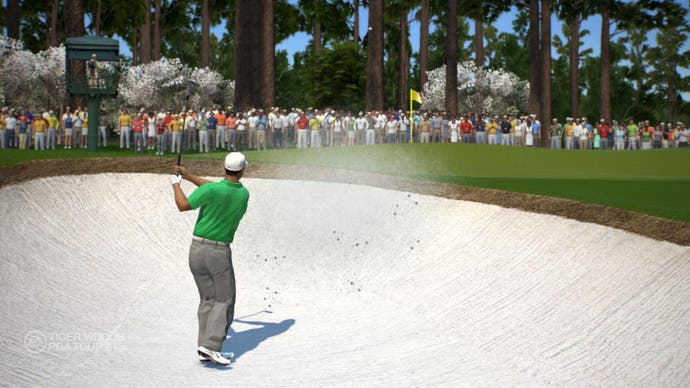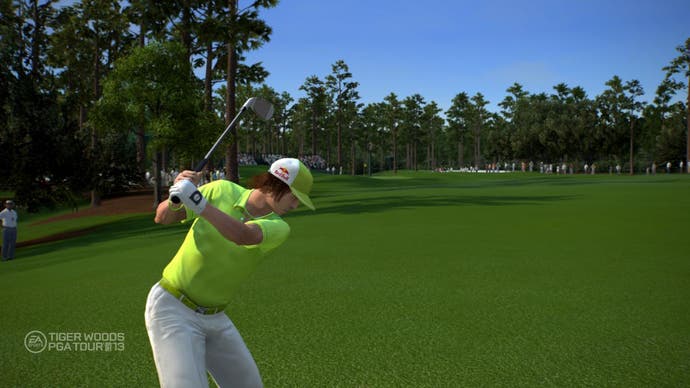Tiger Woods PGA Tour 13 Review
The course whisperer.
Last year's philandering cad is this year's comeback king. 12 months ago, Tiger Woods suffered the ignominy of having his face removed from the box of EA's golfing game owing to his off-tee indiscretions. Yet now he's back, albeit with ruddy-cheeked pretender Rory McIlroy lurking (if such a cuddly man can lurk) in the background. But does this year's game have the feel of a creaky but experienced older stager, or the raw energy of a fresh young whippersnapper?
It's looking its age, that's for sure. It is, quite evidently, a game that has been made on a lower budget than other EA Sports titles. Few people buy golf games for the graphics, but in places this is an ugly game: character models are fuzzy around the edges while the troublingly barren courses are full of flat textures. Some effort has been put into improving the tournament atmosphere, but the handful of spectators in view on some courses doesn't match the noise produced.

Nowhere is this corner-cutting more noticeable than in Legacy mode, a feature deemed worthy of mention on the back of the box. It fancies itself as a story mode, taking you through pivotal moments in Tiger's career, all the way back to when he first picked up a club as a toddler. Even back then, it seems Tiger was destined to front an EA Sports game, as proven by the sponsor's flag in his back yard - but these sepia-toned sequences are set in a world as desolate as the opening of 28 Days Later.
With a bigger budget, we could perhaps have had a moving examination of Tiger's relationship with his golf-mad pop, but instead we're treated to brief snatches of narration in Tiger's soporific tones followed by flat, lifeless scenes of a chubby youngster whacking balls into a post-apocalyptic paddling pool. Tiger's backstory is fascinating and worthy of exploration; here, it's reduced to a poorly presented Challenge mode.
And what of those other back-of-box features? It says much about Tiger that EA Sports sees fit to include a menu option pointing out what's new in case you're having a hard time spotting the differences, but for once, the changes are obvious. Online country clubs are essentially Tiger's version of the localised league modes of other EA Sports games: invite-only competitions that make you feel more than just a number on a leaderboard. There are plenty of daily and weekly live tournaments to compete in, too.

More insidiously, some courses are locked until you earn (or buy) enough coins to purchase the ability to play rounds on them. The idea is to complete the Course Mastery objectives in order to gain unlimited access, but the gold level targets are difficult and plentiful. Playing a single round costs 6000 in-game coins (or 160 Microsoft Points) and the average round won't yield nearly enough for another attempt.
Though these extra courses aren't on the disc, it again raises awkward questions about the nature of service-based gaming and ownership. Fortunately, most of the best courses are already available: golf fanatics will still feel a certain frisson from striding out at Augusta or tackling the back nine of the old course at St. Andrews while being buffeted by blustery winds.
The most significant changes, however, are mechanical. The swing system has been overhauled, and now offers far more detailed and helpful feedback to your stroke. With a controller, you still pull the left stick back and then flick it forward, but your swing is presented in a much more readable way. An arcing stroke meter offers a handy real-time look at how far off centre your backswing is - with accompanying rumble if it's really wild. Then, after the ball has been struck, you'll see a readout that shows your thumb motion in the form of a line; essentially, the straighter it is, the more accurate your stroke will be.

The display also highlights slow backswings or overswing, making it easier to take corrective action on your next shot. All in all, it's a sensible, natural evolution that works for a game intended to welcome novices and experts alike. On the default Pro difficulty, minor deviations won't affect your shots too much, but beyond that you'll need a precise, metronomic motion to get the ball to land where you want it to go.
Both 360 and PS3 versions support motion control alternatives, of course, and the victor in that particular battle may come as a surprise. Move seems tailor-made for golf, particularly as your stance is now perpendicular to the screen so you can get feedback while you swing, rather than realising on your follow-through how badly you screwed up. But it's been poorly calibrated; Sony's device seems oversensitive to the point where it's difficult to hit the ball in a straight line.
It's also very demanding of your play space, requiring you to stand quite some distance back from your TV for the Eye camera to track the controller at every point of your swing. It can be flaky, too, showing a visible wobble of the club even from the cleanest follow-through. Worse still, navigating menus is murderously frustrating.

Kinect has a much greater impact. Even without voice controls, pre-shot adjustments are far simpler, but with voice commands for everything from asking your caddy for advice to selecting your club, it's simpler still. Motion controls are more of a mixed blessing. The swing mechanics are extremely forgiving, but after Move's pernicketiness, its comparative simplicity comes as a relief. It's clear that EA Sports has taken a leaf from Rare's playbook: as in Kinect Sports Season Two, shielding your eyes allows you a closer look at your ball's expected landing spot, while taking a shot is just a matter of clasping your hands together and swinging.
Problems arise when it comes to fine-tuning your aim. Kinect is a device that works best with broad motions, and while its accuracy has improved over time, making tiny adjustments here requires extreme patience. It's rarely a big deal off the tee as there's usually plenty of short stuff to aim for, but putting is a frustratingly imprecise science - especially given how often the game will misread the gestures required to move from swinging to aiming and back. Kinect is supposed to make games more accessible; on the green, it only complicates matters.
Most players, then, are best advised to stick with a standard controller, although in doing so, you're inviting more direct comparisons with previous Tigers. There's no denying that this year's edition plays a good game of golf, and the changes to the game's core systems are well-judged - but they're arguably not enough to make it worth buying again for anyone but the most ardent fan of the sport. While the likes of FIFA have made clear progress in recent iterations, it's hard to see what benefit there is to having a Tiger game every year.
For franchise newcomers, this represents an accessible starter package, but if you've enjoyed a round with Tiger over the last few years and can happily cope without the fun but wayward motion controls, there's little compelling reason to re-invest this time.



